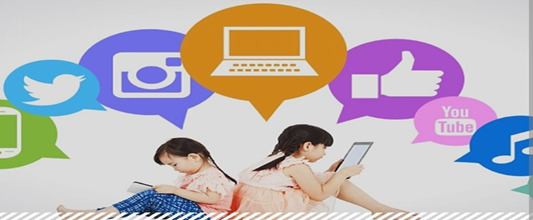Class VIII Life Skills: Navigating Relationships in the Age of Social Media
Life Skills & Value Education – CLASS-VIII – UNIT-5 Communication: Relationships in The Age of

Communication is becoming instant, precise and direct, especially due to the availability of easy-to-use technologies, such as instant messaging and social media platforms. Digital communication channels are gradually replacing traditional communication channels, such as face-to-face conversations, physical letters and fixed-line telephones. How we communicate with each other ultimately affects our relationships. Hence, while we may have innumerable ‘friends’ or ‘followers’ on social media, only a few may be close, trustworthy or dependable. While using various digital modes to communicate regularly, we create our digital footprint online. A digital footprint is a record of information and content that we post or upload on the Internet, such as social media posts, photos and videos, contact information, web pages visited and passwords. It is stored on servers and can always be traced back to the source. We thus have an additional responsibility of safeguarding our privacy and ensuring the accuracy of what we publish.
Let us understand the features, risks and benefits of digital communication.


Advantages of digital communication:

1. Digital communication is instant and live.
- 24×7 connectivity
- Quick decision-making
2. Digital communication enables the use of multiple formats.
- Use of text, photo and video together to create engaging messages
- Personalised and customised messages
3. Digital communication keeps us connected despite physical distance.
- Global connectivity
- Quick access to information, informed decision-making

4. Digital communication is publicly broadcast.
- Quick dissemination of information
- Greater public debates and public support
- Expansion of friends network
- Helps in education
Disadvantages of digital communication:

- Casual approach to conversations
- Expectation of quick responses multiple formats.
- Safety issues due to private media shared in public
- Redundant circulation of message
- Low personal involvement in relationships
- Public display of personal thoughts and feelings
- Increased digital footprint
- Communication is paramount to our social life and how we communicate can either nurture or break relationships.
- When using digital communication, we must understand that the recipients are not in front of us watching or listening to us as we communicate. In the case of digital communication, non-verbal communication such as expressions, tone and gestures are not available to provide additional cues to the recipients. Hence, we should make an effort to express ourselves correctly and clearly, while maintaining the emotions.
- Digital communication is useful when physical constraints such as time, distance or space pose a hindrance. Its ease-of-use helps build a ‘global village’ by facilitating access to information and connecting people. However, by getting too absorbed in the digital world, we sometimes lose out on face-to-face communication, thus taking away the personal touch necessary to nurture relationships. Warmth in relationships warrant interactions, which require people to physically meet and communicate. Depending on the need and the context of the situation, we should wisely choose between digital and traditional forms of communication.
- Conclusion:
- Digital modes of communication are gradually replacing traditional modes of communication due to convenience and ease-of-use.
- Digital media has various advantages, that however may cause an unintentional loss of personal touch necessary while communicating with friends and family.

- A permanent digital footprint is a by-product of our extensive digital communication, which we must be cautious of.
- We must carefully choose our mode of communication, depending on what is being communicated and to whom. Investing time and effort in communication is important to nurture relationships.

Download PDF : ashamodernschool.in Class-8-Life-Skills-2025-26



